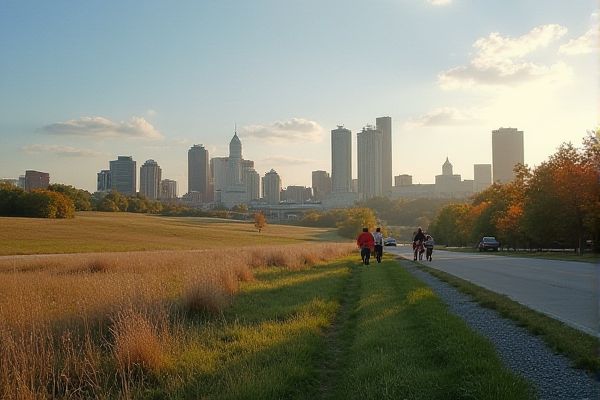
Transportation and commuting in Iowa: Public bus services in major cities. Amtrak trains through main routes. Limited commuter flights available. Bike-friendly trails and lanes. Carpool programs and incentives. Average commute time: 20 minutes. Roads well-maintained, minor congestion. Seasonal weather affects travel conditions. Ride-sharing apps available statewide. Effective driver's license requirements.
Public bus services in major cities.
In Des Moines, the Des Moines Area Regional Transit Authority (DART) operates public bus services through multiple cities, including Des Moines, Altoona, Ankeny, and others, with fixed routes and a free Link Shuttle. For more detailed information on navigating through this city, you can visit the website of Catch Des Moines. In Iowa City, Iowa City Transit offers 13 fixed routes, Monday through Saturday, with all rides currently free under the Fare Free Iowa City pilot program.
Amtrak trains through main routes.
Amtrak services in Iowa are available via two principal routes: the California Zephyr, traveling from Chicago to Oakland and passing through southern Iowa, and the Southwest Chief, which extends from Chicago to Los Angeles, stopping in extreme southeast Iowa, including Fort Madison. Important stations in Iowa encompass Burlington, Creston, Fort Madison, Mt. Pleasant, Osceola, and Ottumwa. For more detailed information, you can explore Amtrak Stations in Iowa on the Amtrak Guide.
Limited commuter flights available.
Des Moines International Airport is expanding its commuter flight options with the addition of two new non-stop routes to Jacksonville, Florida, and Boston, Massachusetts, starting in May 2024. This exciting development increases the total non-stop destinations to 33. The expansion strategically focuses on specific routes to better serve travelers, catering to the growing demands and preferences of Iowa passengers. For more details about this growing connectivity and its impact on Iowa's travel landscape, visit the Travel and Tour World website.
Bike-friendly trails and lanes.
Iowa offers an extensive network of bike-friendly trails and lanes, including hundreds of miles of multiuse trails, detailed trail maps, and information on trail conditions, safety tips, and bicycling laws, all accessible through the Iowa DOT's Interactive Bike Map. The state also has initiatives like the Iowa Data Bike project, which collects data on trail pavement conditions to inform maintenance strategies and enhance the overall biking experience.
Carpool programs and incentives.
UI Rideshare is a free online platform designed to assist University of Iowa employees and students in locating commuting partners for carpool, vanpool, transit, and even cycling or walking. By utilizing state-of-the-art mapping technology along with a cost savings calculator, it streamlines the process of finding compatible commuting matches. In a similar vein, Caravan by DART offers a vanpool service wherein 5 to 12 individuals share a ride to work. This approach not only provides cost savings but also contributes to reduced traffic and environmental benefits, with one volunteer driver enjoying free rides and the rest paying a nominal monthly fare. Meanwhile, HIRTA's Vanpool program offers parallel advantages, including economical monthly rates and 24-hour roadside assistance, ensuring a sustainable and cost-effective commuting method while supporting a guaranteed ride home in case of emergencies.
Average commute time: 20 minutes.
In Iowa, the average commute time varies by county, and although the state average is not explicitly listed, many counties have commute times near the 20-minute mark. For example, Black Hawk County reports an average of 16.1 minutes, while Des Moines County averages 16.4 minutes. Other counties similarly range between 17 to 20 minutes. For more detailed statistics and comparisons across different regions, you can explore resources like Index Mundi.
Roads well-maintained, minor congestion.
While Iowa has made progress in maintaining its roads, with a reduction in poor condition structures and an improved roads grade to "B-", the state still faces challenges such as thousands of bridges and over 403 miles of highway in poor condition, leading to increased commute times due to road repairs. For a comprehensive overview of these developments, the Bipartisan Infrastructure Law will deliver critical insights into ongoing and future projects aimed at enhancing Iowa’s transportation infrastructure.
Seasonal weather affects travel conditions.
Seasonal weather in Iowa significantly impacts travel conditions, particularly during the winter season from mid-October to mid-April. During this time, the Iowa Department of Transportation works diligently to clear roads of snow and ice, ensuring safe driving conditions for residents and travelers alike. As the state's transportation system faces increasing challenges from extreme weather events such as flooding, snowstorms, and high winds, these phenomena are anticipated to escalate due to climate trends. This growing concern highlights the necessity for enhanced resiliency and preparedness measures, underscoring the importance of a proactive approach to maintain safe and efficient transportation infrastructure.
Ride-sharing apps available statewide.
Iowa offers several ride-sharing options that cater to a diverse range of commuting needs, including UI Rideshare specifically for University of Iowa affiliates. Among these options is Caravan by DART, which facilitates vanpooling across a 20-county region, providing a convenient solution for group travel. Additionally, paid ride-sharing services such as Uber and Lyft are widely available, having been approved statewide under Iowa law. For more detailed information about these services, you can visit Iowa's New Way to Connect for Shared Rides, which provides comprehensive insights into each option and how they are integrated within the state's transportation framework.
Effective driver's license requirements.
To obtain an Iowa driver's license, you must document your date of birth, identity, and lawful status or presence in the U.S. Additionally, you need to pass a vision screening and a knowledge test. For individuals under the age of 18, it is also necessary to complete an Iowa-approved driver's education course and meet specific supervised driving requirements. For more detailed information, you can visit the Iowa Department of Transportation website.
